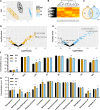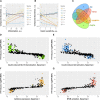Sphingolipid changes do not underlie fatty acid-evoked GLUT4 insulin resistance nor inflammation signals in muscle cells
- PMID: 29794037
- PMCID: PMC6027910
- DOI: 10.1194/jlr.M080788
Sphingolipid changes do not underlie fatty acid-evoked GLUT4 insulin resistance nor inflammation signals in muscle cells
Abstract
Ceramides contribute to obesity-linked insulin resistance and inflammation in vivo, but whether this is a cell-autonomous phenomenon is debated, particularly in muscle, which dictates whole-body glucose uptake. We comprehensively analyzed lipid species produced in response to fatty acids and examined the consequence to insulin resistance and pro-inflammatory pathways. L6 myotubes were incubated with BSA-adsorbed palmitate or palmitoleate in the presence of myriocin, fenretinide, or fumonisin B1. Lipid species were determined by lipidomic analysis. Insulin sensitivity was scored by Akt phosphorylation and glucose transporter 4 (GLUT4) translocation, while pro-inflammatory indices were estimated by IκBα degradation and cytokine expression. Palmitate, but not palmitoleate, had mild effects on Akt phosphorylation but significantly inhibited insulin-stimulated GLUT4 translocation and increased expression of pro-inflammatory cytokines Il6 and Ccl2 Ceramides, hexosylceramides, and sphingosine-1-phosphate significantly heightened by palmitate correlated negatively with insulin sensitivity and positively with pro-inflammatory indices. Inhibition of sphingolipid pathways led to marked changes in cellular lipids, but did not prevent palmitate-induced impairment of insulin-stimulated GLUT4 translocation, suggesting that palmitate-induced accumulation of deleterious lipids and insulin resistance are correlated but independent events in myotubes. We propose that muscle cell-endogenous ceramide production does not evoke insulin resistance and that deleterious effects of ceramides in vivo may arise through ancillary cell communication.
Keywords: ceramides; glucose transporter 4; inflammation; lipidomics.
Copyright © 2018 by the American Society for Biochemistry and Molecular Biology, Inc.
Conflict of interest statement
The authors declare no financial conflicts of interest.
Figures








Similar articles
-
Palmitate-induced down-regulation of sortilin and impaired GLUT4 trafficking in C2C12 myotubes.J Biol Chem. 2010 Nov 5;285(45):34371-81. doi: 10.1074/jbc.M110.128520. Epub 2010 Aug 30. J Biol Chem. 2010. PMID: 20805226 Free PMC article.
-
Extract of Phyllanthus emblica L. fruit stimulates basal glucose uptake and ameliorates palmitate-induced insulin resistance through AMPK activation in C2C12 myotubes.BMC Complement Med Ther. 2024 Aug 2;24(1):296. doi: 10.1186/s12906-024-04592-1. BMC Complement Med Ther. 2024. PMID: 39095777 Free PMC article.
-
Overactivation of NF-κB impairs insulin sensitivity and mediates palmitate-induced insulin resistance in C2C12 skeletal muscle cells.Endocrine. 2010 Feb;37(1):157-66. doi: 10.1007/s12020-009-9283-y. Epub 2009 Nov 24. Endocrine. 2010. PMID: 20963565
-
The twists and turns of sphingolipid pathway in glucose regulation.Biochimie. 2011 Jan;93(1):32-8. doi: 10.1016/j.biochi.2010.05.016. Epub 2010 May 31. Biochimie. 2011. PMID: 20561942 Free PMC article. Review.
-
Unwrapping the mechanisms of ceramide and fatty acid-initiated signals leading to immune-inflammatory responses in obesity.Int J Biochem Cell Biol. 2021 Jun;135:105972. doi: 10.1016/j.biocel.2021.105972. Epub 2021 Apr 14. Int J Biochem Cell Biol. 2021. PMID: 33864951 Review.
Cited by
-
Thirty sweet years of GLUT4.J Biol Chem. 2019 Jul 26;294(30):11369-11381. doi: 10.1074/jbc.REV119.008351. Epub 2019 Jun 7. J Biol Chem. 2019. PMID: 31175156 Free PMC article. Review.
-
Ceramide metabolism associated with chronic dietary nutrient surplus and diminished insulin sensitivity in the liver, muscle, and adipose tissue of cattle.Front Physiol. 2022 Aug 8;13:958837. doi: 10.3389/fphys.2022.958837. eCollection 2022. Front Physiol. 2022. PMID: 36003642 Free PMC article.
-
Plant-derived oleanolic acid ameliorates markers of subclinical inflammation and innate immunity activation in diet-induced pre-diabetic rats.Ther Adv Endocrinol Metab. 2020 Jul 27;11:2042018820935771. doi: 10.1177/2042018820935771. eCollection 2020. Ther Adv Endocrinol Metab. 2020. PMID: 32782775 Free PMC article.
-
Palmitate impairs circadian transcriptomics in muscle cells through histone modification of enhancers.Life Sci Alliance. 2022 Oct 27;6(1):e202201598. doi: 10.26508/lsa.202201598. Print 2023 Jan. Life Sci Alliance. 2022. PMID: 36302651 Free PMC article.
-
Comparative profiling of skeletal muscle models reveals heterogeneity of transcriptome and metabolism.Am J Physiol Cell Physiol. 2020 Mar 1;318(3):C615-C626. doi: 10.1152/ajpcell.00540.2019. Epub 2019 Dec 11. Am J Physiol Cell Physiol. 2020. PMID: 31825657 Free PMC article.
References
-
- Summers S. A. 2018. Could ceramides become the new cholesterol? Cell Metab. 27: 276–280. - PubMed
-
- Boon J., Hoy A. J., Stark R., Brown R. D., Meex R. C., Henstridge D. C., Schenk S., Meikle P. J., Horowitz J. F., Kingwell B. A., et al. . 2013. Ceramides contained in LDL are elevated in type 2 diabetes and promote inflammation and skeletal muscle insulin resistance. Diabetes. 62: 401–410. - PMC - PubMed
Publication types
MeSH terms
Substances
Grants and funding
LinkOut - more resources
Full Text Sources
Other Literature Sources

